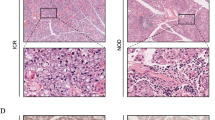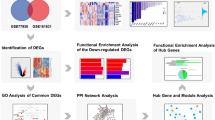Abstract
The purpose of this study was to analyze the temporal gene expression in salivary and lacrimal glands of Sjögren’s syndrome (SS) based on time-series microarray data. We downloaded gene expression data GSE15640 and GSE48139 from gene expression omnibus and identified differentially expressed genes (DEGs) at varying time points using a modified Bayes analysis. Gene clustering was applied to analyze the expression differences in time series of the DEGs. Protein–protein interaction networks were used for searching the hub genes, and gene ontology (GO) and KEGG pathways were applied to analyze the DEGs at a functional level. A total of 744 and 1,490 DEGs were screened out from the salivary glands and lacrimal glands, respectively. Among these genes, 194 were overlapped between salivary glands and lacrimal glands, and these genes were compartmentalized into six clusters with different expression profiles. The GO terms of intracellular transport, protein transport and protein localization were significantly enriched by DEGs in salivary glands; while in the lacrimal glands, DEGs were significantly enriched in protein localization, establishment of protein localization and protein transport. Our results suggest that the SS pathogenesis was significantly different in time series in the salivary and lacrimal glands. The DEGs whose expressions may correlate with molecular mechanisms of SS in our study might provide new insight into the underlying cause or regulation of this disease.




Similar content being viewed by others
References
Sjögren H (1993) Zur Kenntinis der keratoconjunctivitis sicca. Acta Ophthalmol Suppl (Copenh) 2:1–151
Jonsson R, Moen K, Vestrheim D, Szodoray P (2002) Current issues in Sjögren’s syndrome. Oral Dis 8:130–140
Delaleu N, Jonsson R, Koller MM (2005) Sjögren’s syndrome. Eur J Oral Sci 113:101–113
Delaleu N, Jonsson MV, Appel S, Jonsson R (2008) New concepts in the pathogenesis of Sjögren’s syndrome. Rheum Dis Clin North Am 34:833–845
Cha S, Nagashima H, Brown VB, Peck AB, Humphreys-Beher MG (2002) Two NOD Idd-associated intervals contribute synergistically to the development of autoimmune exocrinopathy (Sjögren’s syndrome) on a healthy murine background. Arthritis Rheum 46:1390–1398
Cha S, Peck A, Humphreys-Beher M (2002) Progress in understanding autoimmune exocrinopathy using the non-obese diabetic mouse: an update. Crit Rev Oral Biol 13:5–16
Nguyen C, Cha S, Peck A (2007) Sjögren’s syndrome (SjS)-like disease of mice: the importance of B lymphocytes and autoantibodies. Front Biosci 12:1767
Peck AB, Saylor BT, Nguyen L, Sharma A, She J-X, Nguyen CQ, Mcindoe RA (2011) Gene expression profiling of early-phase Sjögren’s syndrome in C57BL/6. NOD-Aec1Aec2 mice identifies focal adhesion maturation associated with infiltrating leukocytes. Invest Ophthalmol Vis Sci 52:5647–5655
Horvath S, Nazmul-Hossain AN, Pollard RP et al (2012) Systems analysis of primary Sjögren’s syndrome pathogenesis in salivary glands identifies shared pathways in human and a mouse model. Arthritis Res Ther 14:R238
Xuan J, Shen L, Malyavantham K, Pankewycz O, Ambrus JL Jr, Suresh L (2013) Temporal histological changes in lacrimal and major salivary glands in mouse models of Sjögren’s syndrome. BMC Oral Health 13:51
Nguyen CQ, Sharma A, Lee BH, She JX, Mcindoe RA, Peck AB (2009) Differential gene expression in the salivary gland during development and onset of xerostomia in Sjögren’s syndrome-like disease of the C57BL/6.NOD-Aec1Aec2 mouse. Arthritis Res Ther 11:R56
Peck AB, Saylor BT, Nguyen L, Sharma A, She JX, Nguyen CQ, Mcindoe RA (2011) Gene expression profiling of early-phase Sjögren’s syndrome in C57BL/6.NOD-Aec1Aec2 mice identifies focal adhesion maturation associated with infiltrating leukocytes. Invest Ophthalmol Vis Sci 52:5647–5655
Nguyen CQ, Sharma A, She JX, Mcindoe RA, Peck AB (2009) Differential gene expressions in the lacrimal gland during development and onset of keratoconjunctivitis sicca in Sjögren’s syndrome (SJS)-like disease of the C57BL/6.NOD-Aec1Aec2 mouse. Exp Eye Res 88:398–409
Team RDC (2011) R: a language and environment for statistical computing. R Foundation for Statistical Computing
Gautier L, Cope L, Bolstad BM, Irizarry RA (2004) affy–analysis of Affymetrix GeneChip data at the probe level. Bioinformatics 20:307–315
Fujita A, Sato J, Rodrigues L, Ferreira C, Sogayar M (2006) Evaluating different methods of microarray data normalization. BMC Bioinform 7:469
Wirapati P, Sotiriou C, Kunkel S et al (2008) Meta-analysis of gene expression profiles in breast cancer: toward a unified understanding of breast cancer subtyping and prognosis signatures. Breast Cancer Res 10:R65
Aryee M, Gutierrez-Pabello J, Kramnik I, Maiti T, Quackenbush J (2009) An improved empirical bayes approach to estimating differential gene expression in microarray time-course data: BETR (Bayesian Estimation of Temporal Regulation). BMC Bioinform 10:409
Irizarry RA, Hobbs B, Collin F, Beazer-Barclay YD, Antonellis KJ, Scherf U, Speed TP (2003) Exploration, normalization, and summaries of high density oligonucleotide array probe level data. Biostatistics 4:249–264
Tárraga J, Medina I, Carbonell J et al (2008) GEPAS, a web-based tool for microarray data analysis and interpretation. Nucleic Acids Res 36:W308–W314
Da Wei Huang BTS, Lempicki RA (2008) Systematic and integrative analysis of large gene lists using DAVID bioinformatics resources. Nat Protoc 4:44–57
Jensen LJ, Kuhn M, Stark M et al (2009) STRING 8—a global view on proteins and their functional interactions in 630 organisms. Nucleic Acids Res 37:D412–D416
Szklarczyk D, Franceschini A, Kuhn M et al (2011) The STRING database in 2011: functional interaction networks of proteins, globally integrated and scored. Nucleic Acids Res 39:D561–D568
Nguyen CQ, Sharma A, Lee BH, She J-X, Mcindoe RA, Peck AB (2009) Differential gene expression in the salivary gland during development and onset of xerostomia in Sjögren’s syndrome-like disease of the C57BL/6. NOD-Aec1Aec2 mouse. Arthritis Res Ther 11:R56
Horvath S, Zhang B, Carlson M et al (2006) Analysis of oncogenic signaling networks in glioblastoma identifies ASPM as a molecular target. Proc Natl Acad Sci USA 103:17402–17407
Bavi P, Uddin S, Ahmed M et al (2011) Bortezomib stabilizes mitotic cyclins and prevents cell cycle progression via inhibition of UBE2C in colorectal carcinoma. Am J Pathol 178:2109–2120
Viret C, Janeway CA Jr (2003) Self-specific MHC class II-restricted CD4-CD8- T cells that escape deletion and lack regulatory activity. J Immunol 170:201–209
Suh CH, Freed JH, Cohen PL (2003) T cell reactivity to MHC class II-bound self peptides in systemic lupus erythematosus-prone MRL/lpr mice. J Immunol 170:2229–2235
Jabs DA, Enger C, Prendergast RA (1991) Murine models of Sjögren’s syndrome. Evolution of the lacrimal gland inflammatory lesions. Invest Ophthalmol Vis Sci 32:371–380
Brozovic S, Vucicevic-Boras V, Mravak-Stipetic M, Jukic S, Kleinheinz J, Lukac J (2002) Salivary levels of vascular endothelial growth factor (VEGF) in recurrent aphthous ulceration. J Oral Pathol Med 31:106–108
Taichman NS, Cruchley AT, Fletcher LM et al (1998) Vascular endothelial growth factor in normal human salivary glands and saliva: a possible role in the maintenance of mucosal homeostasis. Lab Invest 78:869–875
Zhou B-BS, Elledge SJ (2000) The DNA damage response: putting checkpoints in perspective. Nature 408:433–439
Çelenligil-Nazliel H, Palali A, Ayhan A, Ruacan S (2003) Analysis of in situ proliferative activity in oral gingival epithelium in patients with xerostomia. J Periodontol 74:247–254
Eskelinen E-L, Tanaka Y, Saftig P (2003) At the acidic edge: emerging functions for lysosomal membrane proteins. Trends Cell Biol 13:137–145
Janvier K, Bonifacino JS (2005) Role of the endocytic machinery in the sorting of lysosome-associated membrane proteins. Mol Biol Cell 16:4231–4242
Bagshaw RD, Mahuran DJ, Callahan JW (2005) A proteomic analysis of lysosomal integral membrane proteins reveals the diverse composition of the organelle. Mol Cell Proteomics 4:133–143
Segal B, Thomas W, Rogers T et al (2008) Prevalence, severity, and predictors of fatigue in subjects with primary Sjögren’s syndrome. Arthritis Care Res (Hoboken) 59:1780–1787
Acknowledgments
This work was supported by Shanghai Municipal Health and Family Planning Commission (Project No. 20114016).
Author information
Authors and Affiliations
Corresponding author
Electronic supplementary material
Below is the link to the electronic supplementary material.
Rights and permissions
About this article
Cite this article
Wang, D., Xue, L., Yang, Y. et al. Temporal gene expression analysis of Sjögren’s syndrome in C57BL/6.NOD-Aec1Aec2 mice based on microarray time-series data using an improved empirical Bayes approach. Mol Biol Rep 41, 5953–5960 (2014). https://doi.org/10.1007/s11033-014-3471-4
Received:
Accepted:
Published:
Issue Date:
DOI: https://doi.org/10.1007/s11033-014-3471-4




